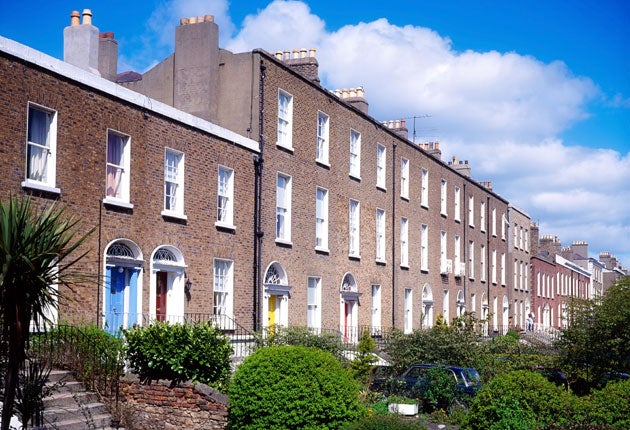Ireland of opportunity
The last two years have been tough for Irish property – but the timemay now be right to pick up a bargain. Laura Latham reports

At the peak of the global boom Ireland was king, riding a wave of prosperity and growth. Tax incentives brought in international companies, there was full employment and property hit prices that left even seasoned professionals gasping.
At the peak of late 2006, house prices, which rose 300 per cent within 10 years, hit unprecedented levels. Small terraced homes in Dublin were selling for £450,000 and standard suburban three-bedroom homes were approaching £1m.
For a small country with a large rural population it all seemed too good to be true and, unfortunately, it was. The balloon started to deflate through 2007, and 2008’s economic meltdown hit Ireland hard. As banks were bailed out by the government and unemployment rose to 12 per cent, questions were asked about the way Ireland’s investment and finance houses were run.
Meanwhile, property prices plummeted by an average of 50 per cent countrywide. The housing market was so bad in January that local bookmaker, Paddy Power, was taking bets on the percentage by which punters were expecting prices to drop this year.
“The downturn hit every sector, especially the new-build market. Lots of developers went bust leaving half-finished or empty apartments all over town,” says Dublin estate agent Juliet Gethin. “The only people buying are those who have to and there’s no investment market. You’ll get a better return from other assets.”
The good news is that along with overseas buyers, first-time buyers and those forced to rent have a better chance of buying something decent. “Prices of family homes in good areas of Dublin average £350,000 to £530,000,” says Gethin, “they used to fetch around £1m.”
In central areas of Dublin, you can pick up a good one-bedroom holiday bolt hole from around £135,000, for two-beds you’re looking at £170,000 plus. Victorian or beautiful Georgian townhouses start at around £850,000 but that often gets you four to five bedrooms. Further from the centre, in one of the waterside regeneration areas, such as Usher’s Island or Hanover Quay, you can find new studios and one-beds from around £100,000 up to £450,000 for stylish penthouses.
“There’s a shortage of quality family homes but an oversupply of apartments,” explains Gethin, who also believes a lot of prospective buyers are waiting to see if prices will fall further this year. “There’s talk that 20 per cent more stock will come on to the market and prices will drop around 10 per cent.”
However, so many Irish buyers either overpaid or are now in negative equity they’re holding on to property, rather than selling, in the hope things will improve.
Rose Holden, of agents DNG, says this has kept some movement in the market as buyers have less choice and prices in prime areas have stayed higher than expected. She says there’s also a government moratorium on bank repossessions. “So we’re not seeing as many coming to the market.”
A trawl through sales portal Daft.ie shows a lot of property across the country with widely varying prices. Rural areas have seen bigger falls than the capital and there are half-acre land parcels everywhere with planning permission from around £45,000, while small holiday cottages and renovation projects go for as little as £50,000.
In popular regions nearer to Dublin, such as Wicklow or Louth, expect to pay from around £130,000 for nice two-bed village homes and new two-bed apartments. Though it’s possible to pay anything from £170,000 to £350,000 for good detached three- and four-bed houses and period renovations, depending on location, condition and the vendor’s circumstances.
According to economist Ronan Lyons of Drafti.e, it’s difficult for investors to gauge prices at the moment because the statistics just aren’t there. “There’s a lack of official data and lists of asking prices don’t necessarily give an indication of sale prices,” he explains. “A lot of the information the banks would normally give is on hold because they aren’t lending.”
Lyons also believes that though prices have dropped significantly in Dublin, falls across other areas of the country are bringing down averages. He says that where a lot of new development took place in central and northern counties, developers are slashing prices to attract buyers. “I’m hearing of two-bedroom properties selling for around £76,000, two years ago they’d have been at least twice that.”
For those wondering if it’s time to invest in Ireland, Lyons believes there are deals to be done “providing you do your homework”. However, he doesn’t think values are likely to come down much more overall and says the question is whether investors can afford to hold property for the long term.
“Rents dipped by 25 to 30 per cent because properties flooded the market after the crash,” he explains. “It’s good for tenants but not landlords. The idea you can make money in two to five years is now unrealistic. Investors need to be thinking in terms of 10 to 15 years.”
The government is predicting Ireland will start to come out of recession by the end of this year and unemployment has dropped slightly. However, real recovery is unlikely to be soon. “Ireland is a resilient country,” adds Lyons, “and we don’t take ourselves too seriously. At the moment, there’s a bizarre masochism in the fact that if we’re no longer the best in Europe, we may as well be the worst.”
Subscribe to Independent Premium to bookmark this article
Want to bookmark your favourite articles and stories to read or reference later? Start your Independent Premium subscription today.

Join our commenting forum
Join thought-provoking conversations, follow other Independent readers and see their replies